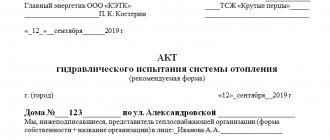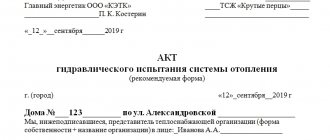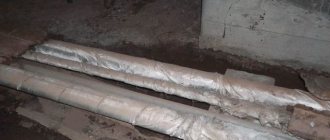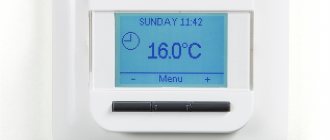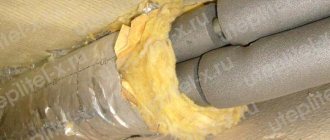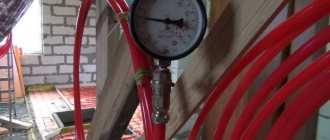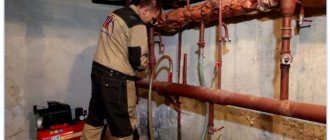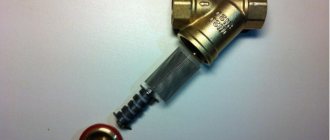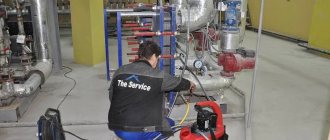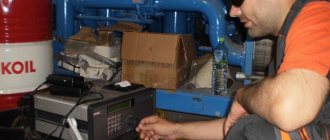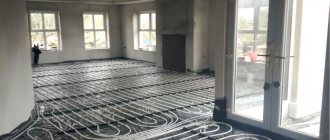INTERNAL COLD AND HOT WATER SUPPLY SYSTEMS
4.4. Internal cold and hot water supply systems must be tested by hydrostatic or manometric method in compliance with the requirements of GOST 24054-80, GOST 25136-82 and these rules.
The test pressure value for the hydrostatic test method should be taken equal to 1.5 excess operating pressure.
Hydrostatic and pressure testing of cold and hot water supply systems must be carried out before installing water taps.
Systems are considered to have passed the tests if, within 10 minutes of being under test pressure using the hydrostatic test method, no pressure drop of more than 0.05 MPa (0.5 kgf/cm2) and drops in welds, pipes, threaded connections, fittings and water leaks are detected through flushing devices.
At the end of the hydrostatic test, it is necessary to release water from the internal cold and hot water supply systems.
4.5. Manometric tests of the internal cold and hot water supply system should be carried out in the following sequence: fill the system with air at a test excess pressure of 0.15 MPa (1.5 kgf/cm2); if installation defects are detected by ear, the pressure should be reduced to atmospheric pressure and the defects eliminated; then fill the system with air at a pressure of 0.1 MPa (1 kgf/cm2), maintain it under test pressure for 5 minutes.
The system is considered to have passed the test if, when it is under test pressure, the pressure drop does not exceed 0.01 MPa (0.1 kgf/cm2).
Do-it-yourself washing
Flushing heating systems is necessary to eliminate excess debris inside it. Recommendations, according to SNIP, suggest flushing the system at least once per heating season. This allows you to keep the inner surface of pipes and radiators clean and, as a result, improve their thermal conductivity and coolant circulation. Ideally, it is recommended to remove them to wash the batteries, but in extreme cases, you can use a pump. It is not difficult to assemble a pump for pressure testing the system with your own hands; in general, you can use any circulation pump that works with liquid, and a pressure gauge measuring pressure is not needed for flushing.
Flushing heating systems is necessary to eliminate excess debris inside it. Recommendations, according to SNIP, suggest flushing the system at least once per heating season.
Dirty pipes in the heating system
For flushing, the pump is connected on the back side of the battery against the normal circulation of the coolant; this improves the flushing results due to the fact that the scale formed inside the pipe is deposited in the form of scales directed along the flow of the coolant.
Methods
Currently, washing is carried out in several ways according to OKPD:
- The chemical cleaning method involves the use of acids and alkaline solutions.
- Electric pulse cleaning - electrical discharge occurs in the water, which leads to the destruction of scale and its subsequent removal by regular washing.
- OKPD provides for washing batteries with water hammer, which is created by a special apparatus.
HEATING AND HEAT SUPPLY SYSTEMS
4.6. Testing of water heating and heat supply systems must be carried out with the boilers and expansion vessels turned off using the hydrostatic method with a pressure equal to 1.5 working pressure, but not less than 0.2 MPa (2 kgf/cm2) at the lowest point of the system.
The system is considered to have passed the test if, within 5 minutes of being under test pressure, the pressure drop does not exceed 0.02 MPa (0.2 kgf/cm) and there are no leaks in welds, pipes, threaded connections, fittings, heating devices and equipment.
The test pressure value using the hydrostatic test method for heating and heat supply systems connected to heating plants must not exceed the maximum test pressure for heating devices and heating and ventilation equipment installed in the system.
4.7. Manometric tests of heating and heat supply systems should be carried out in the sequence specified in clause 4.5.
4.8. Surface heating systems must be tested, usually using the hydrostatic method.
Manometric testing can be carried out at negative outdoor temperatures.
Hydrostatic testing of panel heating systems must be carried out (before sealing the installation windows) with a pressure of 1 MPa (10 kgf/cm2) for 15 minutes, while the pressure drop is allowed no more than 0.01 MPa (0.1 kgf/cm2).
For panel heating systems combined with heating devices, the test pressure value should not exceed the maximum test pressure for the heating devices installed in the system.
The test pressure value of panel heating systems, steam heating and heat supply systems during manometric tests should be 0.1 MPa (1 kgf/cm2). Test duration – 5 minutes. The pressure drop should be no more than 0.01 MPa (0.1 kgf/cm2).
4.9. Steam heating and heat supply systems with operating pressure up to 0.07 MPa (0.7 kgf/cm2) must be tested by the hydrostatic method with a pressure equal to 0.25 MPa (2.5 kgf/cm2) at the lowest point of the system; systems with a working pressure of more than 0.07 MPa (0.7 kgf/cm2) - hydrostatic pressure equal to the working pressure plus 0.1 MPa (1 kgf/cm2), but not less than 0.3 MPa (3 kgf/cm2) in the highest point of the system.
The system is recognized as having passed the pressure test if, within 5 minutes of being under test pressure, the pressure drop does not exceed 0.02 MPa (0.2 kgf/cm2) and there are no leaks in welds, pipes, threaded connections, fittings, or heating devices.
Steam heating and heat supply systems, after hydrostatic or pressure testing, must be checked by starting steam at the operating pressure of the system. In this case, steam leaks are not allowed.
4.10. Thermal testing of heating and heat supply systems at positive outside temperatures must be carried out at a water temperature in the supply lines of the systems of at least 333 K (60 °C). In this case, all heating devices should warm up evenly.
If there are no heat sources during the warm season, a thermal test of heating systems must be carried out upon connection to a heat source.
Thermal testing of heating systems at negative outside air temperatures must be carried out at a coolant temperature in the supply pipeline corresponding to the outside air temperature during testing according to the heating temperature schedule, but not less than 323 K (50 °C), and the circulating pressure in the system according to the working documentation .
Thermal testing of heating systems should be carried out within 7 hours, while checking the uniformity of heating of the heating devices (to the touch).
Conditions for performing crimping
Test work is carried out correctly if all necessary requirements have been met. For example, outside work cannot be carried out on the tested object, and the testing must be supervised by the shift supervisor.
Pressure testing is carried out only according to a program approved by the company’s chief engineer.
It defines: the procedure for employees and the technological sequence of verification .
They also outline safety measures for ongoing and current work performed at adjacent facilities. There should be no strangers during pressure testing of the heating system; there should be no turning on or off of testing devices; only employees taking part in the test remain on site.
When work is carried out in adjacent areas, it is imperative to provide reliable fencing and turn off the testing equipment.
Inspection of heating appliances and pipes is permitted only at operating pressure values. When the heating system is pressure tested, reports are filled out to confirm the tightness.
BOILER HOUSES
4.11. Boilers must be tested using the hydrostatic method before lining work is carried out, and water heaters - before applying thermal insulation. During these tests, the heating and hot water supply systems must be disconnected.
Upon completion of hydrostatic tests, it is necessary to release water from boilers and water heaters.
Boilers and water heaters must be tested under hydrostatic pressure along with the fittings installed on them.
Before hydrostatic testing of the boiler, the covers and hatches must be tightly closed, the safety valves are jammed, and a plug must be placed on the flange connection of the flow device or bypass closest to the steam boiler.
The test pressure value for hydrostatic tests of boilers and water heaters is accepted in accordance with the standards or technical specifications for this equipment.
The test pressure is maintained for 5 minutes, after which it is reduced to the maximum operating pressure, which is maintained for the entire time required to inspect the boiler or water heater.
Boilers and water heaters are recognized as having passed the hydrostatic test if:
during the time they were under test pressure, no pressure drop was observed;
There were no signs of rupture, leakage or surface sweating.
4.12. Fuel oil pipelines should be tested with a hydrostatic pressure of 0.5 MPa (5 kgf/cm2). The system is considered to have passed the test if, within 5 minutes of being under test pressure, the pressure drop does not exceed 0.02 MPa (0.2 kgf/cm2).
Crimping procedure
This method of checking the heating system involves performing hydraulic tests:
- Heat exchangers;
- Boilers;
- Pipe
This makes it possible to identify leaks that indicate depressurization of the network.
Before testing the heating system with plugs, you should isolate the heating system from the water supply, visually assess the reliability of all connections , and also check the functionality and condition of the shut-off valves.
After this, the expansion tank and boiler are turned off to flush the radiators and pipelines from various deposits, debris and dust.
During the hydraulic test, the heating system is filled with water, but during air tests this is not done, but simply a compressor is connected to the drain valve. Then the pressure is increased to the required value, and its indicators are monitored with a pressure gauge. If there are no changes, then the tightness is good, therefore the system can be put into operation.
When the pressure begins to decrease beyond the permissible value, it means that defects are present . Leaks in a filled system are not difficult to find. But in order to identify damage during an air test, a soap solution should be applied to all joints and joints.
Air pressure testing takes at least 20 hours, and hydraulic testing takes 1 hour.
Having corrected the identified defects, the procedure is repeated again, and this must be done until good tightness is achieved . After carrying out this work, pressure testing certificates for heating systems are filled out.
Checking the heating network with air is usually carried out if it is impossible to fill it with water, or when working in low temperature conditions, because the liquid can simply freeze.
INTERNAL SEWERAGE AND DRAINS
4.13. Testing of internal sewerage systems must be carried out by pouring water by simultaneously opening 75% of the sanitary fixtures connected to the area being tested for the time required for its inspection.
The system is considered to have passed the test if, during its inspection, no leaks were detected through the walls of the pipelines and joints.
Tests of sewer outlet pipelines laid in the ground or underground channels must be carried out before they are closed by filling them with water to the level of the ground floor floor.
4.14. Tests of sections of sewerage systems hidden during subsequent work must be carried out by pouring water before they are closed with the drawing up of an inspection report for hidden work in accordance with mandatory Appendix 6 of SNiP 3.01.01-85.
4.15. Internal drains should be tested by filling them with water to the level of the highest drain funnel. The duration of the test must be at least 10 minutes.
Drains are considered to have passed the test if no leaks are found during inspection and the water level in the risers has not decreased.
Certificate of pneumatic testing of pipelines
Pneumatic method: diagnosis by pumping the system with high pressure air. Often the method is used for external systems if the temperature on the thermometer is less than +5 Celsius.
The procedure for crimping pipes by pneumatic testing is given in the same SanPiN; the test report is drawn up in the required form, which is given in Appendix No. 3.
Requirements for drawing up test documentation:
- Filling in the name of the city and the date of compilation.
- Indication of the members of the commission (as in the hydraulic test, three parties are involved).
- Description of the pipeline: length, diameter, material of pipes and joints.
- Information about the pressure value: calculated value, to what value the pressure in the pipes was increased, final pressure, amount of reduction. The crimping time is indicated.
- In the “Decision of the Commission” section, each of its members signs with a transcript if the pipeline has passed pneumatic diagnostics and is sealed and durable.
Roof fencing test report
Technical requirements and roof testing methods are enshrined in the same GOST as the standard for fire escapes and stepladders (53254-2009).
Tests are carried out at intervals of five years, integrity checks are carried out every year. The results are documented in acts.
The conditionally completed act can be divided into three parts:
- General information. Information about the tested object and the inspecting organization is entered here.
- Information about the inspection (what manipulations were carried out, what tools were used).
- Test results (compliance with GOSTs, integrity and safety of the structure).
The agreement of the commission members during testing is confirmed by their personal signatures.
Organizations with a license from the Ministry of Emergency Situations have the right to conduct inspections and tests. Defects found must be corrected.
Fire test reports
During testing for the performance and safe operation of fire equipment, several reports are drawn up:
- checking fire hydrants;
- diagnostics of internal water supply;
- checking for the safety of use and compliance with labor protection rules of fire escapes.
Fire hydrants
Testing the performance of hydrants for water loss is carried out twice a year and is often combined with checking the fire-fighting water supply system. Based on the results of the inspection, an act is drawn up and signed by the commission. Mandatory members: a representative of the fire inspection and a representative from the organization in which the inspection is taking place. Also, the commission may consist entirely of company employees.
The act states:
- general organizational information (information about the company, date and place of compilation);
- the main part describes the members of the commission and the progress of the test. Information about hydrants is presented in tabular form. The location address, diameter, pressure, water yield and affiliation of the hydrant are indicated;
- in the final part, compliance (or non-compliance) with the requirements of the hydrant condition is established.
At the end, the act is signed by authorized members of the commission.
Internal fire water supply
The act establishes the presence or absence of defects and malfunctions in the fire water supply system. The inspection is carried out by responsible employees of the enterprise. Frequency – at least twice a year; for flammable industries, inspections may be scheduled more often.
Internal fire water supply (IFP) is a complex system of pipes, sensors, and switches. Therefore, it is often checked by a labor protection or fire safety specialist, as well as by persons who are trained in fire safety.
The act is drawn up on letterhead or plain paper indicating the details. Be sure to register:
- information about the organization and participants of the inspection;
- information about the object being checked;
- inspection results;
- recommendations for eliminating defects and malfunctions, if any are found;
- signatures of responsible persons.
